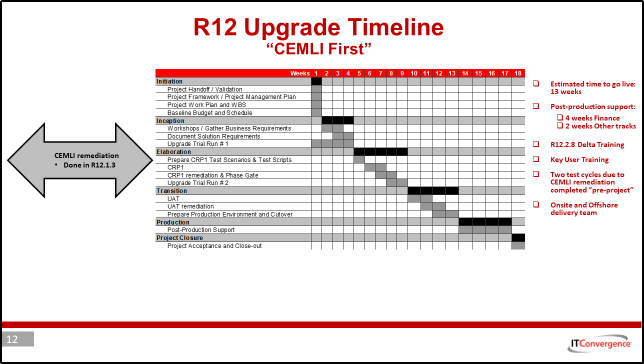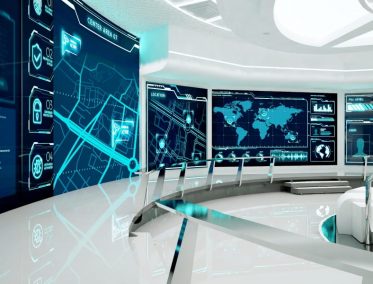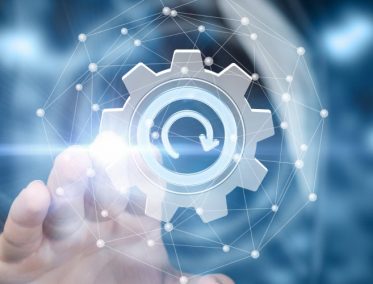Note: This blog was originally published in December 2020
CEMLI – Overview
After the premier support for Oracle EBS ended, many companies have either entered Sustaining Support, which only offers limited maintenance and no access to new patches, fixes, or updates, or upgraded their EBS. Companies which are yet to upgrade must act before it’s too late. And, while upgrading your Oracle EBS, one of the important factors you must consider is CEMLI remediation
CEMLI, which is the short form of Configurations/Customizations, Extensions, Modifications, Localizations/Internationalization, and Integration, is key when strategizing for your Oracle EBS upgrade. Nearly all EBS instances ever deployed contain some level of CEMLIs as all customers use their own combination of personalization to Oracle EBS to make it operate in the exact way, they need it to.
Unlike previous Oracle EBS upgrades, in an upgrade to R12.2 oftentimes the technical effort to complete the upgrade outweighs the functional effort. A traditional upgrade process involves assembling a team of functional, technical, and DBA resources through three test cycles (CRP, SIT, and UAT), followed by a Go Live and one month of post Go Live support. In the past, for example, when upgrading from Oracle EBS 11i to R12, the bulk of the effort was Functional in nature due to the new features introduced in R12, such as Subledger Accounting.
The most important new features in R12.2 are Technical and not Functional, so the bulk of the upgrade effort is also technical, with the most prominent technical work being CEMLI Remediation to meet R12.2 standards.
Now, it’s important to note there is both CEMLI Remediation and CEMLI Modernization. CEMLI Remediation is the process of meeting the minimum requirements to make existing customizations work correctly in R12.2, while CEMLI Modernization involves making an extra effort to move an existing CEMLI (e.g., a custom form) from older Oracle technology to newer Oracle technology. Both Remediation and Modernization are important considerations for your EBS roadmap, with Remediation being a near term necessity. Modernization is the best-case scenario that customers would ideally perform if they had enough time to migrate customizations to the newest technology as part of the upgrade. Unfortunately, given the timeline we specified earlier, for many customers this is no longer feasible.
So, how much effort is involved to meet the minimum EBS R12.2 upgrade standards?
CEMLI Remediation Effort
 Based on the number and complexity of CEMLIs, the effort can range from hundreds to thousands of hours. A typical upgrade project spans anywhere from 5 to 7 months, but it depends on the company’s requirement.
Based on the number and complexity of CEMLIs, the effort can range from hundreds to thousands of hours. A typical upgrade project spans anywhere from 5 to 7 months, but it depends on the company’s requirement.
CEMLI Remediation gets the limelight during an Oracle EBS upgrade because it dramatically impacts the amount of effort in terms of resources and time. If a customer is using standard functionality and zero CEMLIs, the upgrade testing process would be standard, and the upgrade could be completed relatively quickly.
But this is rarely the case. CEMLIs are the main culprit when it comes to problems during an upgrade because – unlike standard functionality that has been extensively tested by Oracle already – CEMLIs need to be tested and retested to make sure everything works correctly before the upgrade can go live.
CEMLI Compliance Assessment
When it comes to CEMLI, your goal should be to eliminate or avoid customizations and use standard functionality whenever possible. You need to set really high standards of what criteria needs to be met to determine if customizations are deemed necessary.
We recommend that you follow best practices when customizing Oracle EBS to make sure that your instance adheres to the minimum R12.2 development standards (CEMLI Remediation) and that you migrate customizations to the newest technology where possible (CEMLI Modernization).
Methods to use to assess Oracle CEMLI compliance:
CEMLI Remediation
-
- Ensure adherence to standards by running the Global Standards Compliance Checker (GSCC) and using readiness reports to determine Oracle CEMLI compliance with R12.2 development standards
- Disable obsolete setups and configurations
- Drop obsolete database objects and files
- Validate the upgraded Oracle EBS instance using the new upgrade analyzer
- Replace any customizations made by modification with extensions and personalization (both for Remediation and Modernization)
CEMLI Modernization
-
- Migrate from Legacy Oracle Reports to BI Publisher
- Migrate from Legacy Oracle Forms to ADF
CEMLI Benefits
Because a CEMLI upgrade is so important to an upgrade and potentially complex in nature, ITC created the “CEMLI First” approach where CEMLI Remediation can be performed in R12.1, prior to all other aspects of the upgrade to EBS R12.2. The upgrade itself is divided into two parts, the technical part which involves CEMLI Remediation being done in R12.1, and the functional part being done as part of the R12.2 upgrade patching process.
- CEMLI Remediation:
- Shortens the timeline of the R12.2 upgrade itself by getting CEMLI Remediation completed and fully tested in the R12.1 instance, reducing the testing cycles required for the R12.2 upgrade
- CEMLI Modernization:
- Prepare for potential migration or coexistence to Oracle Cloud ERP
- Prepare for potential integration of other siloed applications in the Cloud
- Ensure agility to respond to changing requirements
- CEMLI Remediation and Modernization:
- Prepare for potential migration of Oracle EBS to Cloud Infrastructure (both for Remediation and Modernization)
- Gain benefits from newest and better-supported technologies, same look and feel as standard Oracle EBS application components, same features, and functionality as standard Oracle EBS application components
- Optimize employee productivity
- Optimize customer and vendor experience
- Lower cost and complexity of ownership
By prioritizing CEMLI Remediation and Modernization, you can significantly reduce risks, costs, and time spent on your EBS R12.2 upgrade as a comprehensive CEMLI assessment and inventory is created against your instance to analyse how they adhere to functionality in R12.2.
Out of this analysis, a CEMLI plan is put in place to assign resources and perform all the necessary changes in the code of your current R12.1 EBS environment. The necessary tests are performed and the CEMLI upgrade is deployed to production to provide further “real-life” functionality testing that is more robust and exhaustive than the typical tests executed during a three-test cycle upgrade project.
As a result, once the R12.2 functional upgrade project begins, CEMLIs can be treated more like Oracle standard functionality, reducing the time spent during the upgrade project, which also translates into reduced costs and risks.
Benefits of Partnering with a CEMLI Consultant
Your EBS team sometimes needs expert help and knowledge to navigate how to scope, adapt, optimize, and get the most value out of your investment. The effort you invest here should also involve a comprehensive design of short-term and long-term strategies regarding not only your EBS upgrade but the continued optimization of EBS capabilities.
Here are the top 4 reasons why you should consider partnering with a consultant to perform CEMLI Remediation and help you down the road with the EBS upgrade or migrate project.
Unique and Profound Knowledge: Experienced CEMLI consultants have developed in-depth knowledge over dozens of projects on how best to remediate CEMLIs, which will set your EBS upgrade or migrate project on the road to success. As stated earlier, CEMLI Remediation can be a critical area that takes a heavy toll on technical resources and the overall technical effort of an upgrade, so having an expert on deck who employs best practices from beginning to end can benefit you greatly.
Risk Minimization: Partnering with a team of consultants helps you minimize, or virtually eliminate, a number of risks associated with addressing CEMLIs and upgrading your EBS on your own. Time and again, we’ve seen clients go over budget, exceed the expected timeline, or fail to comply with R12 standards, all of which stem from not having the proper know-how at hand. It is easy to set off down the wrong path on CEMLI Remediation the first time you try it, and having experienced resources working side by side with you will help you avoid that trap.
Training: If you’re interested in having your team learn about how to remediate CEMLIs or upgrade EBS to R12.2, you could benefit from using a resource-sharing model that guides you through the process and ensures that your team learns critical aspects of CEMLI Remediation as part of the overall EBS upgrade or migrate project. It also provides an important foundation for your team to continue to develop and maintain R12.2 CEMLI “the right way” going forward.
Cost Reduction: CEMLI consultants are not only experts in this critical area, but they’ve also worked on numerous projects that have uniquely positioned them to know many of the bottlenecks or pitfalls that may come up during CEMLI Remediation. Thus, they can quickly address issues or prevent them from happening altogether when possible. As far as an EBS upgrade or migrate project, you can also reduce costs by using a resource-sharing model where our consultants take the lead to show your team what needs to be done so that your own team can perform a significant portion of the remediation tasks, helping you save money along the way.
Customizations always factor into the effort of upgrading EBS, especially when upgrading to R12.2. Improperly addressing CEMLI remediation can result in additional work, costs, and staff training to ensure that CEMLI are working properly according to R12.2 standards.




